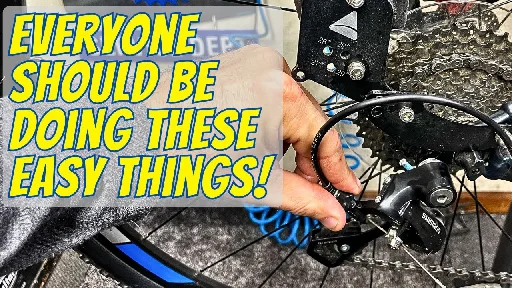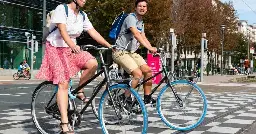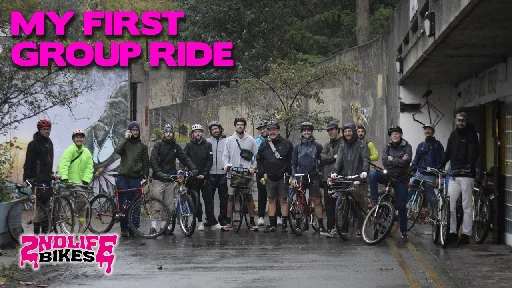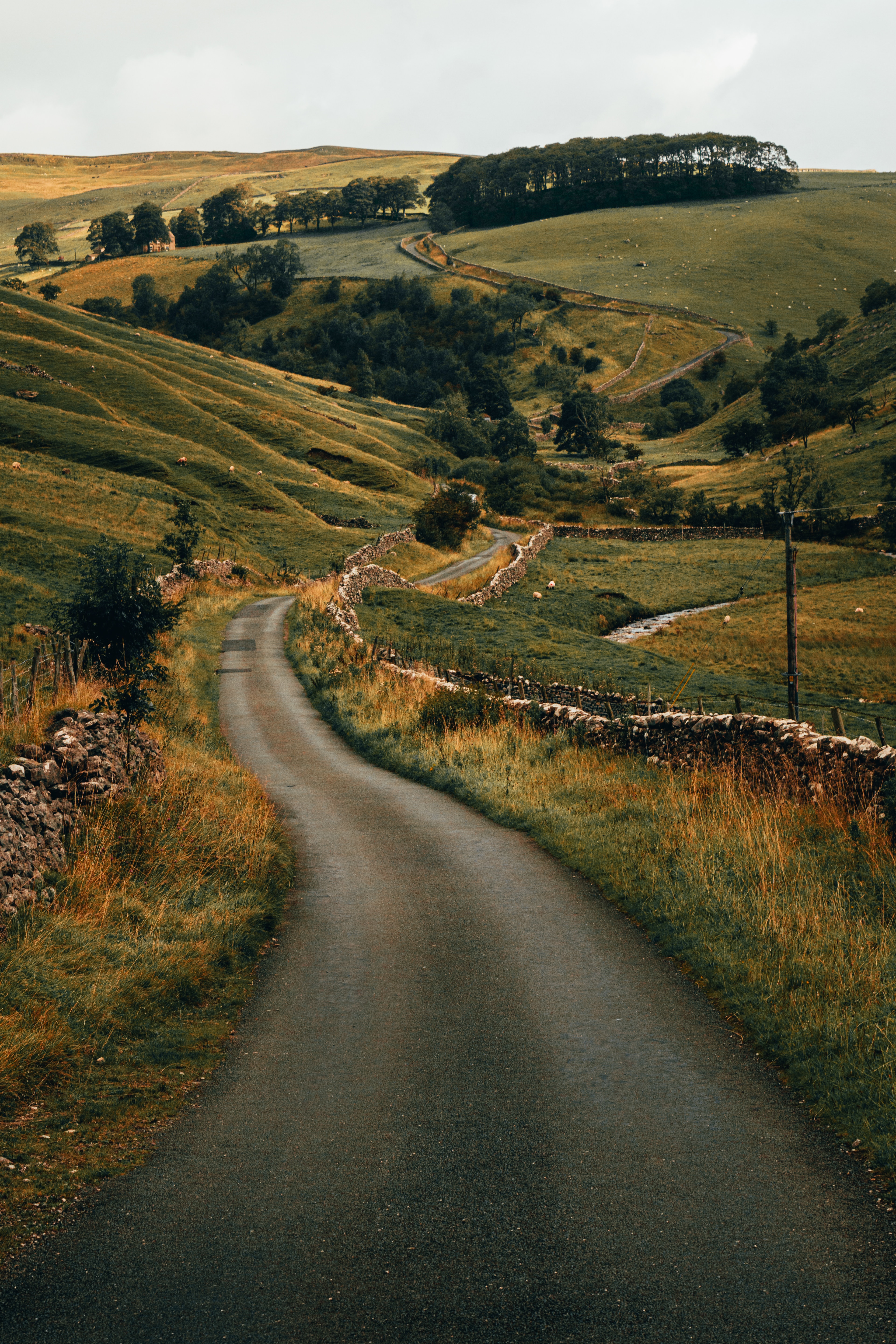
Casual Cycle
- Government's 500W and throttle e-bike proposals are 'unnecessary, risky and the wrong approach' say UK trade bodiesebiketips.road.cc Government's 500W and throttle e-bike proposals are 'unnecessary, risky and the wrong approach' say UK trade bodies
The government’s recent e-bike proposals to double the legal wattage of motors to 500W and allow ‘twist and go’ e-bikes with throttle control up to 15.5mph are ‘unnecessary’, ‘risky’, and the ‘wrong approach’, the Bicycle Association (BA) and Association of Cycle Traders (ACT) have said. The Departm...
- Long form video [1:26.45] He Lost His Arm, Now He's Cycling 2500 Miles – The Wild Ones Podcast Ep.40 SPECIAL

YouTube Video
Click to view this content.
Found Dan's story and personality to be really engaging. I know videos don't go down too well but anyone looking for something to listen to this Friday might be interested.
- How my average commute has been recentlyyoutube.com THIS IS WHY YOU DON’T BUY A £275 MOUNTAIN #BIKE!
I pushed this cheap £175 mountain bike to the limits in the £10000 Bike vs Budget bike challenge and it only lasted one day of riding MTB trails and jumps, w...
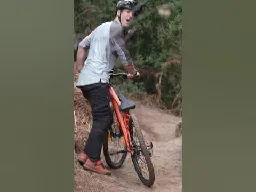
- Probably the only mountain bike maintenance video you'll ever need [video 1:26:16]

YouTube Video
Click to view this content.
A really random low-key suggestion from YouTube at lunch turned out to be some ancient-buried gold from back when YouTube was much better.
- EBIKE: A good article for bafang users that want a setup for peddlingtalesontwowheels.com BBSHD Programming For The Pedaling Cyclist
(But Not For The Throttler) There is a follow-on to this article that tinkers with these settings a bit further. In August 2023 I published another update that passed along what I’m doing dif…

This focuses on the BBSHD, but they cover a lot of the terminology, with the focus on using the ebike part as an assist and for cargo bikes and not a replacement. It should be applicable to anyone with the ability to configure their e-bikes.
- Can you live in a remote cottage with just a bicycle? [video 20:14]
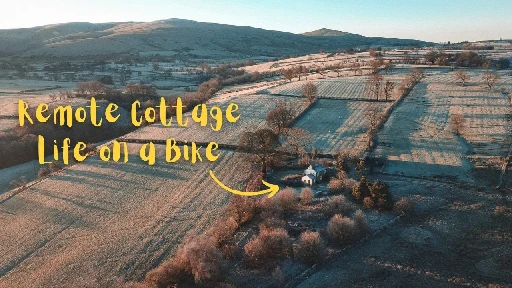
YouTube Video
Click to view this content.
- Eurovelo 6 from France to Germany in 2022 (part 1) video [10:49]

YouTube Video
Click to view this content.
I use the ev-12 every day kind of low-key wish to do a whole one some day
- Watch: How to clean a bike in the time it takes to make a cup of teawww.cyclist.co.uk Watch: How to clean a bike in the time it takes to make a cup of tea | Cyclist
Cyclist's expert mechanic gives few simple tools and techniques that will help you clean your bike in next to no time

- Schwalbe's "flat-less" isn't "flat-never"

Had a lot of trees down in my area and I picked up the most perfectly stright blackthorn right through the guard material of my marathon plus'
- Proof Hybrids are the best tactical vehicle "Watch a UK Cop Commandeer a Bike and Ram a Drug Dealer"www.griffonnews.com Watch a UK Cop Commandeer a Bike and Ram a Drug Dealer
Footage out of the UK shows a police constable commandeering a bicycle in order to catch a drug dealer. Veuer’s Matt Hoffman reports.

- Santander Cycles UK explains how its bikes benefit riders and the environmentwww.bedfordshirelive.co.uk Santander Cycles UK explains how its bikes benefit riders and the environment
More than 280,000 nextbike pedal bike rentals have been taken out since the launch of the scheme
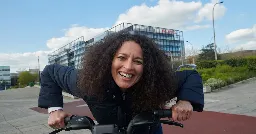
- 10 Cheap But Excellent Cycling Products [video 8:35]
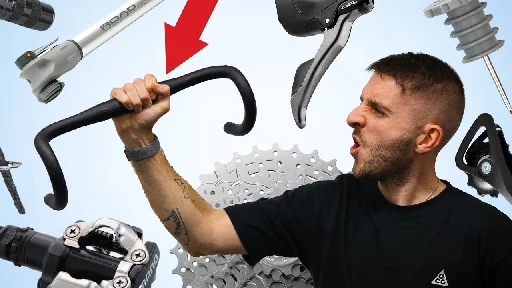
YouTube Video
Click to view this content.
- Cyclings Best Kept Secret [Video 8:21]
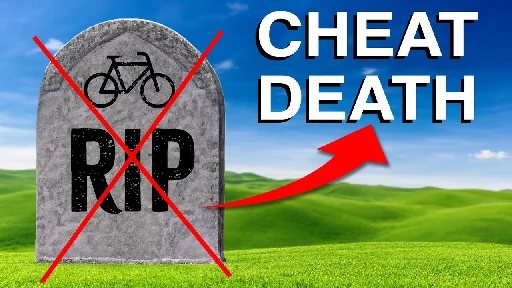
YouTube Video
Click to view this content.
Video from Everything's Been Done discussing the health benefits of everyday cycling.
- Building a human powered minivan out of a Surly Big Dummy video [13:45]piped.kavin.rocks Piped
An alternative privacy-friendly YouTube frontend which is efficient by design.

- MTB trail etiquette - can winter riding damage trails?off.road.cc MTB trail etiquette - can winter riding damage trails?
Many riders assume they understand the potential damage effect of riding in wet and muddy conditions but unless you have shaped and shovelled some dirt, you probably don’t. Winter is the wear season for bikes and trails, with both exposed to enhanced mechanical and material wear. For riders, the iss...
- The DARK SIDE of Electronic Shifting No One Talks About [Video 10:14]

YouTube Video
Click to view this content.
- Are Chainless String Drive Bicycles a Genius or Terrible Idea? [Video 12:49]

YouTube Video
Click to view this content.
- Basic Bicycle Tuneup ANYONE can do at home! Cannondale hybrid revival! [Video 19:10]
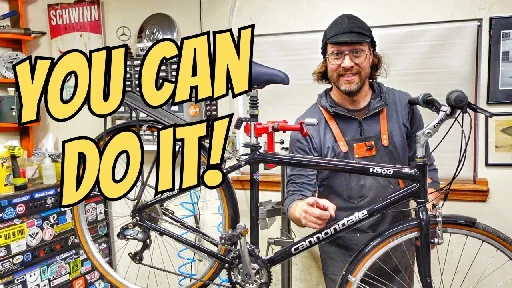
YouTube Video
Click to view this content.
- How do you deal with road rage?
Nights and mornings are getting darker her in the northern hemi and weathers getting bad which makes it more frequent things will happen.
I totally let myself down this morning. Tesla pulled out on my after doing a u-turn in and out of a cul-de-sac and not giving way as I passed. Dudes windows were still misted up, he knew what he did because I got the usual hazard light thank-you, but I couldn't help shout out "check next time mate". This guy decided it would be a good idea to change direction and speed past a school to have a chat. No raised voices or any real aggro he asked if he impeded my travel I said I hit the brakes and if I had to do that then yeah mate you messed up. Informed him that we were now holding up traffic, to which they sped off.
It's prob my worst habit on a bike, I think it stems from my time on motorbikes. It's just never worth my time
- Pedal the low road: cycling coast-to-coast across southern Scotlandwww.theguardian.com Pedal the low road: cycling coast-to-coast across southern Scotland
We ride the Kirkpatrick C2C, a new 250-mile route across lowland Scotland and stopping at bike-friendly hotels and cafes along the way
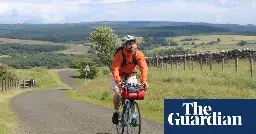
Pedal the low road: cycling coast-to-coast across southern Scotland headphone stoped share more Ad Follow Story by Stuart Kenny • 3mo
The weather-beaten curves of a battered stone wall guide me out of Langholm, an idyllic old textile town tucked between the hills of the Esk valley, eight miles north of the English border.
As I pedal slowly around a steep corner, a lamb and her mother, grazing on the grassy fringes, scurry off up the road. I appreciate their show of faith in my cycling abilities, but on gradients of 9%, I wouldn’t have been able to keep their pace even if they’d crawled off. I pause for a breather at the MacDiarmid Memorial, a huge, metal sculpture of an open book, embellished with images from the work of the great poet Hugh MacDiarmid, who was born in Langholm.
The artwork depicts thistles, trout, eagles and ploughs, while the green of the forests and farmland behind shine through the silhouettes etched out of the framework. “Scotland small? Our multiform, our infinite Scotland small?” MacDiarmid famously wrote. It certainly doesn’t feel small when you’re cycling across it.
I’ve been on my bike for a few days at this point, riding the Kirkpatrick C2C; south Scotland’s new coast-to-coast route, which runs 250 miles from Stranraer in Dumfries and Galloway on the west coast to Eyemouth in the Borders on the east. The waymarking will come next year, but the route is online now for experienced cyclists inspired to ride by the world’s first ever combined UCI World Championship events, which started last week, and are currently being contested around Scotland.
“The bike is part of our identity and culture here,” says Paula Ward, of South of Scotland Enterprise, one of various tourism bodies involved in the creation of the Kirkpatrick C2C. “The area is well known for cycling already, but this gives people a pre-logged route that you can download,” says Ward. “That makes it easy to come here to the south of Scotland to explore, having watched something like the World Championships or the Tour of Britain.”
The route is named after Kirkpatrick Macmillan, the Dumfriesshire blacksmith widely credited as having invented the first pedal-driven bicycle in the 1830s. “It’s one of our universal truths,” says Ward. “The south of Scotland gave the world the bike.”
Dumfries and Galloway is sometimes called Scotland’s forgotten corner, and after the decline of the textile industry in the 80s, Langholm risked becoming Scotland’s forgotten town. The Langholm Initiative was set up in 1994 to change that, and in 2019, they led a community buyout of the local moorland. Today, the community owns 4,200 hectares (10,500 acres) of this sublime countryside – and has transformed an old grouse moor into the Tarras Valley nature reserve.
The Kirkpatrick C2C cuts through the heart of the reserve, on a single-track road looking out to Solway Firth. The moorland is dotted with naturally regenerating birch, rowan and alder trees, spreading up the valley from the ancient forest, along the River Tarras. I stop to watch wild goats butt horns at the side of the road, and spot a hen harrier gliding in the distance.
I had rolled out of Stranraer a few days earlier, after breakfast at the Fig & Olive cafe, where the toilets are plastered with posters of classic climbs and a cycling jersey is framed on the wall.
There are two suggested itineraries for the route – a four-day “Challenger” ride or an eight-day “Explorer” option, both covering the same 250 miles. I opt for a version of the latter, riding an average of 30 miles a day, with overnight stays in Wigtown, Castle Douglas, Dumfries (the largest town on the route), Langholm, Hawick, Melrose and Coldstream before reaching Eyemouth. The route combines sleepy B and C-roads and national cycle routes to guide you safely across the country.
My first day stretched 32 miles past ocean, forest and farmland to Wigtown, Scotland’s charming National Book Town. There, I explored the nooks and crannies of The Bookshop, Scotland’s largest secondhand bookshop. I socialised at The Open Book, a not-for-profit which lets tourists run a bookshop for a week, and met The Bookshop Band – folk musicians Ben Please and Beth Porter – who write songs inspired by books and perform them in bookshops. “It’s the community here that makes it special,” Please says. And, presumably, the 15 bookshops.
After a night in the Booktown Bunkhouse, I descend from misty vistas of the salt marsh and mudflats of Wigtown Bay through farmland, to the River Cree and Newton Stewart. The route turns away from the coast, into the Galloway Hills, and I detour past Creetown to see the Big Water of Fleet Viaduct, part of an old railway line featured in John Buchan’s The 39 Steps.
I soon reach the pastel houses of Kirkcudbright, a harbour town with MacLellan’s Castle at its centre and a vibrant arts scene. It’s here that trail-setter Pete Corson, who provided the spine of the Kirkpatrick C2C route, runs cycling tour operator Trailbrakes. “You come past Barlocco Island, and it’s unspoiled and rolling,” he says, of the section of trail on his doorstep. “You follow gorse bushes, and come to a view down Kirkcudbright Bay, out to the isle of Little Ross.”
I ride on, via winding climbs and pastoral panoramas, to Castle Douglas, a town known for its food and its cycling. The two collided back in 2016. “Mark Cavendish crashed into the Chinese on the corner on the Tour of Britain,” David Fulton, owner of the King’s Arms Hotel, tells me. Cav would return in 2022 – this time sprinting safely past the Jade Palace to win the British National Road Championships. There’s a reason these events keep coming back here.
“It’s a cycling town,” Fulton says. “We’ve got hills, coast and this huge network of quiet roads.” I’m served a calorie-rich full Scottish breakfast at the hotel (marginal gains) before being sent on my way.
In Dumfries, I grab a coffee at the Frothy Bike Co – a magnet for cyclists hunting hard-earned caffeine, and via Lockerbie and a lush road by the River Esk, I roll into Langholm, 150 miles in. After the Tarras valley, the route passes from Dumfries and Galloway into the Scottish Borders.
I descend to Newcastleton, unfortunately one day late for the Copshaw Common Riding – an annual festival where they mark the town boundaries. In most Borders towns, this riding occurs on horses. Here, they use bikes – though not before some peculiar pageantry. The “snogging of the sod and supping of the tequila” particularly stands out on the eccentric order of ceremony.
Six miles on, I come to Hermitage Castle, a fierce 14th-century fortress. I’m the only visitor and am left to explore the ancient staircases alone. Mary Queen of Scots once rode 25 miles on horseback to visit her future husband, the Earl of Bothwell, here, and Sir Walter Scott adored the castle. The remainder of the route passes through an abundance of Scott history – from Selkirk, where the Waverley author sat as sheriff, to Abbotsford, his lavish Tweedbank palace.
I cycle past the 12th-century Borders abbeys of Melrose, Dryburgh and Kelso, before a buzzard leads me into Coldstream, where I spend my final night at Bank House, overlooking a bend in the Tweed that marks the border. Golden hour has hit the river when I wake. Siskins flutter around damp roadside hedges, and hares dash through fields as I ride the final 25 miles to Eyemouth.
When gulls begin to circle, I know I’m near. One final climb, then I roll down to the east coast waves, which lap gently on to Eyemouth beach, backdropped by red sandstone cliffs.
As a Scot, there’s something special in riding this coast-to-coast, putting home into context and bringing the map of the country to life. The Kirkpatrick C2C is a cycling colossus; an education in Borderland beauty and community, with a deep literary, historical vein throughout.
“Scotland small?” The words of MacDiarmid pop back into my head as I watch a tourist toss a fish down to a chunky harbour seal. It doesn’t feel small when you’ve cycled across it.
The Kirkpatrick C2C runs 250 miles from Stranraer to Eyemouth. Get more details from Scotland Starts Here
- How to stick to cycling as a new rider over the winter monthswww.cyclingweekly.com How to stick to cycling as a new rider
Taken up cycling over the summer and keen to stick at it? Ellie Donnell brings you the tips and tricks to keep your motivation high

How to stick to cycling as a new rider Taken up cycling over the summer and keen to stick at it? Ellie Donnell brings you the tips and tricks to keep your motivation high
rider in winter gear cycling on beautiful road (Image credit: Andy Jones for Future) So, you’ve done a few rides and think this cycling malarky might be for you? The trick now is to make sure you’re in it for the long haul.
One of the hardest parts of taking up a new sport, cycling or otherwise, is staying motivated enough to keep going. I definitely didn't cycle consistently when I started, and had to keep coming back to it again and again before I properly fell in love with the sport. Why? A few reasons. There’s the small fact that cycling is pretty darn hard, and for a long time I didn’t feel like I was making any progress. Poor weather conditions are another major hurdle, with winter being a particularly difficult period for any cyclist.
For many, consistency and motivation around training are the most challenging elements when it comes to sticking to a new sport. So, what steps can new riders take to ensure they're in it for the long haul, and not just a couple of sunny days a year? From setting monthly goals to ensuring you have the right gear, there are plenty of things you can do to make getting back on your bike that much easier. This isn’t about how to be a fitter, faster cyclist - rather, how to go from someone who dabbles in the odd cycle to becoming a dedicated rider. Period.
Start slow Image shows a rider on an endurance bike ride.
One of the most common mistakes when starting a new discipline is going out way too hard at the beginning. It’s really tempting to want to tackle a long ride, or attempt to commute five days a week from the off, but if you’re totally new to training, you’ll likely end up experiencing physical and mental burnout before you’ve barely started. The trick is to start slow, and build up your endurance over time so that your body can learn to adapt to the new load and stresses placed on it.
RECOMMENDED VIDEOS FOR YOU... Besides, becoming a cyclist doesn’t mean you have to endure gruelling, high-intensity rides all the time. The main thing is to keep your training consistent and sustainable, which means choosing a pace, distance and frequency that suits your ability. Cycling should add to your life, not take away from it, so choose your workouts wisely and listen to your body.
Set monthly goals Writing goals in a notepad
Although it’s not about becoming the fastest rider on the road, tracking your progress and seeing improvements can be one of the best, and most rewarding, parts of taking up cycling. Especially if you’re totally new to the sport, when it’s much easier to make ‘beginner gains’, as you tend to see progress happen quickly.
If you’re the type of person who loves to tick off a list, then setting monthly goals might be the motivation you need to get on your bike. A distance-based target is the obvious choice, but there are plenty of measurable goals you can choose to track. Maybe it’s commuting to work at least twice a week, or attempting a new route every month? Perhaps you prefer doing laps of your local park and you have a specific time you’d like to beat?
If you need a little help coming up with monthly goals, you could always join Cycling Weekly's own 'CW5000' challenge - complete with a Strava club and active Facebook group to keep you motivated. Challenges vary from time and distance challenges, to 'find the silliest road name you can' - so there's plenty to keep you engaged!
The important thing is to be realistic - don’t set yourself wild targets that are practically impossible to achieve. This will only demoralise you. Keep your goals conservative at the beginning to ensure you’re able to hit them consistently, then increase the mileage (or whatever your goal is) very gradually month by month. It’s the small, incremental changes that add up.
Do it with a friend Penge cycling club ride
Sure, solo rides have their place, but if you’re just starting out and need a touch more motivation, then group rides are a really important hack for sticking at cycling. Riding with friends is so much more enjoyable! There’s nothing better than heading out into the countryside with a few of your mates, grabbing a coffee on route, and breathing in some fresh air.
Linking up with a training buddy can also be a useful tool for keeping yourself accountable. If you’ve planned to go for a ride with a friend, it’s much harder to back out knowing you’ll let your friend down. Plus, it’s always nice having someone there to spur you on during really tough rides.
Keep it varied mountain bike trail
Doing the same rides all the time, be it your daily commute or laps of your local park, is bound to get boring after a while. So, mix it up! If you can, vary your route to work every other day to reduce cognitive fatigue. Or, plan a few destination rides with a different end point each time.
If you usually ride on the road, think about checking out your local mountain bike trail centre - hire bikes are nearly always available, so there needn't be a barrier to entry in terms of bike ownership.
One of the things that transformed my view of cycling was going on rides in beautiful places. Being outdoors on your bike is a great way to see the world, whether that’s venturing over to a new part of town or even a new country. I’m sure there are many people who will agree that one of the best things about cycling is the freedom it gives you - you can go pretty much anywhere on a bike. So, take a trip!
Get the right kit cyclist zips up a thermal jersey
Having the right gear will make or break your relationship with cycling during the winter months. I once lost my best winter cycling gloves for a couple of months and didn’t do a single ride until I finally bought a new pair. It happens, but it’s best to be prepared from the off.
You don’t need to buy a ton of fancy kit to start off with either, but making sure you have the basics is really important, especially when the weather turns colder. A good pair of gloves is essential, as are acquiring a few effective layers that will keep you warm, while ensuring you remain light on your bike. A quality waterproof will serve you time and again, too.
Finally, a set of the best bike lights, front and rear, are crucial as the days get shorter, especially if you’re commuting and only travelling when it’s dark.
Set the conditions for success Cyclist ready to commute to work
To ensure you consistently get back on your bike, make it as easy as possible for yourself. Have a think about the hurdles that might be stopping you from going on that ride - and change them! Is your bike stored somewhere that’s difficult to access? Do you struggle to get all your kit together before work?
When I know I’m going to cycle to the office in the morning, I make sure I have my bag ready the night before so I don’t have to think about it when I’m bleary eyed at 7am. I also always make sure to check the weather, so I can plan my cycling gear accordingly. If it’s drizzly, pack a raincoat. Is it set to be cold? You’re going to need a few layers and a pair of gloves.
If your bike is tricky to access, perhaps consider bringing it inside your home the night before a ride so you don’t have to think about retrieving it the next day. Nutrition and fuelling are important too - if you’re planning on doing a big ride at the weekend, try and eat a substantial, carbohydrate rich meal the night before to ensure you have the energy to sustain you on a ride.
Just a little bit of planning will go a long way to ensuring cycling success.
Think about training indoors cyclist pedals indoors on a turbo trainer
If the idea of cycling in the dark and cold during the winter months still doesn’t appeal, then you might want to consider investing in an indoor bike, or turbo trainer which you can attach your own bike to. They can be an expensive option, but there are lots of benefits to indoor cycling: you won’t experience any interruptions on a ride, it’s easier to be consistent with training and, crucially, you don’t have to deal with poor weather conditions.
Plus, there are a wealth of indoor cycling apps such as Zwift, TrainerRoad and MyWhoosh which come suited and booted with a huge range of pre-set rides, making it much easier to gamify the cycling experience for an extra slice of motivation. Training indoors also allows you to focus on a specific discipline, whether that’s doing intervals, hills or long sustained efforts.
Accept that not every ride will be your best ever Cyclist checks computer
This one is really important to keep in mind. Not every ride will be your best, and that is absolutely fine. You’re building so much more than just physical fitness with every ride and, actually, those harder cycles are often the ones that make you more resilient over time, by building mental toughness.
Instead, focus on enjoyment as much as possible - fitness and speed can come later. As a cycling newbie, it’s important to create habits that last, build up your confidence and, ultimately, allow you to fall in love with the sport.
Take the pressure off and remember that you’re in this for the long run. There will always be another ride.
- Brexit, lack of cash, politics: has the UK cycling revolution run out of road?www.theguardian.com Brexit, lack of cash, politics: has the UK cycling revolution run out of road?
Bike sales boomed during the pandemic, but now cycle shops are going bust, sales of ebikes are sluggish and there’s a downturn in ‘active travel’

When Alice Clews-Smith and her partner, Kitty, moved to London, they didn’t see many options for pursuing their shared passion for cycling.
“I think it’s fair to say that the industry and the cycling scene were very male dominated,” she said. “There was a lack of space for women, trans-femme, non-binary people. We wanted a space where these people could feel welcomed and included. And because not everything is about going fast in Lycra.”
So was born the Steezy Collective, which brings together cyclists across the UK. Not that going fast is off the table. The collective noticed that there were no women in the Fastest Known Times list for the Lakeland 200 route – 200km of mountain bike trails through the Lake District – so they set about correcting that, and now the list includes nine women riders, with their efforts captured on film. The existence of the Steezy Collective and others such as Sisters in the Wild, the Lakes Gravel Gang, the New Forest Off Road Club and 6am Cycling is part of a new wave of enthusiasts fuelled by the lockdown bicycle boom. Riders are now much more diverse than the cliched and not entirely accurate stereotype of middle-aged men in Lycra.
With miles of cycle paths opening up in cities across the UK, people reacted during the pandemic lockdowns by buying bikes in record numbers, with latecomers facing months-long waits. By March 2021, cycle traffic in England was 64% higher than in December 2013.
Now that has all changed. Last week, Wiggle Chain Reaction Cycles, one of the UK’s largest online cycle retailers, went into administration while Islabikes, which transformed the design of children’s bikes to make them lighter and easier to handle, said that it would stop manufacturing. The announcements came after three major UK distributors went bust, along with German company Signa Sports United, and the Italian firm Bianchi announced redundancies, Cycling Weekly reported.
The whole industry generates about £7.5bn of added value to the UK economy and employs about 64,000 people
Phillip Darnton, Bicycle Association So what went wrong?
“We could see it before anyone else,” said Martin Shepherd at Reynolds Technology in Birmingham, which for the past 125 years has made steel tubes used to create bicycle frames.
“During the pandemic, you couldn’t ship bikes fast enough,” he said. “Everybody’s lead time for orders [mostly to Taiwanese factories] started to go up nine months in advance, 12 months in advance.
“Now we’ve come out of the other side of it, there’s just vast amounts of inventory because all those people who were having to order 500 bikes 18 months in advance were suddenly swamped with stock.”
Customers, on the other hand, had been hit hard in their bank accounts. Sales have dipped, leaving companies with stock that’s proving hard to shift – something analyst Velco described as an economic “whiplash effect”, where small changes are magnified down the supply chain. Some bikes can now be bought at steep discounts since 2024 models will be arriving in a matter of weeks.
Shepherd said high interest rates, as well as post-Brexit trade barriers, were also playing their part. UK firms have specialised in mid- and high-end bikes, and sales to Europe had been substantial, but they have been hit by customs delays and extra charges. Now is an excellent time to buy a bike, but those bargains come with a price tag for the sector. If the market is flooded with more cheap stock, it could drive more firms out of business.
UK bikes shops have record stocks just at the point when potential customers are facing a cost of living crunch. Photograph: David Pearson/Alamy UK bikes shops have record stocks just at the point when potential customers are facing a cost of living crunch. Photograph: David Pearson/Alamy © Provided by The Guardian “In the long term, it could result in less choice for consumers because the more high street shops that shut, the less people there are to fix a bicycle or advise them,” said Jonathan Harrison, director of the Association of Cycle Traders, which represents retailers and repairers.
There have already been “quite a lot” of closures, he said, and there are now about 2,700 bike shops in the UK and another 1,100 workshops, hire centres and bike cafes.
“The likes of Wiggle closing will have impacts on other businesses, too, because a lot of distributors have been over-reliant on them as a sales channel,” Harrison said. “So we will see further repercussions happen, particularly in the supply chain. But I think the market will bounce back. We still think there is room for growth in the number of people cycling.”
There is another headwind for cyclists blowing from Westminster. Inspired by a narrow victory in the Uxbridge byelection in July, Rishi Sunak declared the end of an alleged “war on drivers”.
Whether that amounts, as some fear, to a declaration of a new war on pedestrians and cyclists remains to be seen – the prime minister’s plan for drivers includes a clampdown on 20mph speed limits, bus lanes and low-traffic neighbourhoods (LTNs), having slashed funds for cycle lanes and pavements in March.
There used to be cross-party consensus on active travel, but there’s been a substantial change over the last 18 months against anything perceived to be green
Duncan Dollimore, Cycling UK Last Friday, the Commons’ public accounts committee said there had been “disappointingly slow” progress on increasing active travel. The Department for Transport has been ordered to conduct an LTN review and has canvassed views from local authorities, which campaigners say could lead to reopening rat runs closed years ago by tarmacking over cul-de-sacs and ripping out bollards and other so-called modal filters.
“During Covid we saw a massive increase in levels of cycling,” said Duncan Dollimore, head of campaigns at Cycling UK. “Since then, the numbers have dropped substantially and we’ve lost all the benefits. And part of the reason is government policy.
“There used to be a cross-party consensus on active travel, but there’s been a very substantial change in tone over the last 18 months. The whole narrative from the government has been very much against anything that’s perceived to be green, and it’s quite toxic.”
He said that a media campaign with “a certain degree of vilification of people cycling has an effect on people and then puts people off. The narrative against cycling isn’t helping these local industries.”
Phillip Darnton, the chair of the Bicycle Association, which represents larger manufacturers and retailers, said they have been trying to persuade ministers that the cycling industry presents an opportunity to boost economic growth.
“The whole industry is surprisingly valuable,” he said. “It’s probably generating about £7.5bn of added value to the UK economy and, if you include livelihoods, employs about 64,000 people.”
Islabikes, which transformed children’s bikes to make them lighter and easier to handle, recently said it would cease manufacturing. Photograph: James Sturcke/Alamy Islabikes, which transformed children’s bikes to make them lighter and easier to handle, recently said it would cease manufacturing. Photograph: James Sturcke/Alamy © Provided by The Guardian While it is often tempting to look enviously at the Netherlands and Denmark, which have been investing in cycling and cycle lanes since the 1973 oil crisis, Darnton pointed to Germany as inspiration. “In Germany last year they sold about 2.2m electric bikes and were disappointed they couldn’t satisfy the last 100,000 orders,” he said. “In the UK, we struggled to sell 150,000.”
France has had huge growth in ebike sales, he added, because the government had offered some modest subsidies. “The French say it’s not about how many euros or pounds but the very fact that the government says: ‘This is the strategy – we want to urge you not to use a car for short urban trips’ and makes it attractive for businesses to make deliveries in the last mile by cargo bike.”
Cargo bikes – larger, usually electric, bikes with a separate carrier – are one remaining bright spot, with people adopting them in growing numbers.
The trend is particularly noticeable in Cambridge, where it was instrumental in shielding Outspoken Cycles, which sells and services bikes in the city, from the worst of the lockdown effects, according to the shop’s general manager, Robert Hampton.
“We haven’t had the overstock issue for cargo bikes,” he said. “We’re now back to a lead time of about four weeks. It’s been steady growth: 20% more this year than last year, and 20% more last year than the year before. It’s much more of a steady increase of people looking more to move out of using a car for everyday journeys.”
Meanwhile, there are still plenty of riders who take the sport seriously, whether that’s taking one of the dozens of routes through the flat Cambridge Fens or the hills of the Yorkshire Dales. While appetites for a £300 commuter bike have waned, people who want to add another £10,000 bike to their collection are still doing so, according to Shepherd.
At 6am Cycling, there is room for both types of rider. The club was started by Tom Glendining and Lesley Sharpe in 2015 and really took off when they began their Fri-Day rides – a dawn trip through Epping Forest followed by a fry-up.
“It just started through a group of us going out really early on a Friday morning,” Glendining said. “And more people started joining.
“Everything’s shifted. Loads of girls getting into it now, which is fantastic. There’s Brothers on Bikes trying to get Muslim dudes out on bikes – they’ve started joining the fry-up rides as well. It’s not all about going fast – although we’ve got them too. There’s guys who ride with 6am who are incredibly strong riders and have done national time trials and all that. They’re all really lovely people. The main thing is you’ve got to be nice.”
- An Unexpected Way To Learn Bike Balance [Video 6:48]nuv3d-7iaaa-aaaan-qahma-cai.raw.ic0.app Piped
An alternative privacy-friendly YouTube frontend which is efficient by design.

- 6 Ways You Can Learn to Love Your Autumn Commutewww.welovecycling.com 6 Ways You Can Learn to Love Your Autumn Commute
When you envision a cycle commute, your mind will conjure images of bustling cycle lanes through bright city centres. The roads are dry, the air is warm,
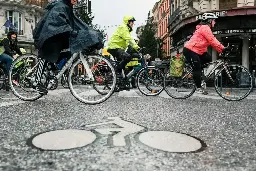
When you envision a cycle commute, your mind will conjure images of bustling cycle lanes through bright city centres. The roads are dry, the air is warm, and the puddles are sparse. It’s easy to see why so many people might make this a regular part of their routine throughout the summer.
But once September rolls around, everything changes. The rain arrives, in what seems like an incessant nature. The small potholes that you would occasionally skirt round now fill with water and seem to grow every day. The dark mornings mean you don’t always see them, despite knowing this route like the back of your hand. Is that a new pot hole?!
Your once thriving commute seems less appealing as time goes on. Is that it for the year? But wait! Don’t give up yet! Without getting too spiritual, there are so many ways you can embrace the change and maintain your love for the cycle commute throughout autumn.
Embrace the CX season Being a roadie commuter is easy in the summer. But once the leaves begin to fall, the combination with rain and mud creates a near-treacherous route on slick tyres. You’re right to be a little cautious, so instead of banishing your bike to the garage for the next 6 months, embrace your new persona as a cyclo-cross rider and switch things up.
Sanne Cant Embrace the cyclo-cross season. © Profimedia Switch your tyres As part of embracing your inner-cyclocross racer, you’ll want to switch up your tyres. If you’re converting a road frameset, then you’ll want to consider tyres that are as narrow as possible – say 30 mm, but that are knobbly for the autumnal change in road surface. Though if you’ve got slacker geometry, like that of a touring frameset, then you’ll have a little more clearance for a slightly wider tyre. Whatever you switch your tyres for, you’ll likely feel much more stable when you’re slicing through piles of muddy leaves on your way to a 9 am meeting.
Lower the pressure If you’ve only ever ridden a road bike on your commute to work, then you’re likely used to pumping your tyres up to the max. But if you want the added benefit of those knobbly tyres, then you’ll want to drop the pressure.
Autumn brings damp road surfaces, and other potential hazards, with possibly even the first frost of the year, so having softer tyres enables those bumpy bits of your tyre to grip to every small on the ground, reducing your risk of injury and speeding you up on those rushed mornings.
Change your route With your fresh new tyres, and an acceptance that you might get a bit damp and muddy on your commute, it might be time to change up your route.
Riding roads in the sunshine is a blissful sport in its own right, but come the wetter months, and the spray that comes from passing traffic can make those dark mornings miserable. Have you discovered any off-road sections between your home and work? Try breaking out of your routine and incorporate the odd bridleway into your commute, you’ll get away from traffic and add a bit of added nature to your day. You’ll be surprised at how many there are even in urban areas too.
Be sure to check your routes out in advance of an early start, so you’re not panicking on your way to work when you accidentally end up on a path not exactly suited to bikes.
Mudguards Whilst you can blame passing cars for road spray all you like, it’s possible that the majority of the wet is coming from your own tyres, if not from the sky of course. Getting wet on your way to work is less than ideal, especially if it’s preventable. If that’s the case, then it’s mudguard season!
The world of mudguards can be an overwhelming one, so we’ve a couple of suggestions for a range of requirements, or you can read our more comprehensive guide here.
First consider how wet it actually is, if you’re encountering the odd muddy puddle then an ass-saver could be a quick, easy win. They’re super light, and you can keep them in your commuting bag in times of need. However, they do have their limitations and offer no protection to your legs or bike components.
If you’re in a damper climate, then a slightly larger clip-on mudguard could be a better option, but still suitable for a quick and easy installation. This pair of front and back mudguards from Planet X are an affordable option for all-round coverage. Full coverage mudguards are available for those long, damp months when you’ll be commuting daily and want to avoid getting any wetter than you need to.
Peeling off your tights every day when you’ve arrived at the officer but it’s not actually rained can be quite demoralising. German brand SKS offer a great variety of mudguards suited to every bike and tyre. It’s worth bearing in mind that if you’ve swapped out your tyres for bigger CX tyres, then make sure you’ve got enough clearance for full mudguards, and SKS have the range of sizes to get the perfect fit.
Be bold, start cold (but don’t forget your waterproofs) Autumn is that tricky time between hot and cold, where the weather doesn’t quite know what it’s doing, and you’ve not acclimatised either way. So when the temperature dips below 10 C (50 F), you’re likely to reach for your thermals a little bit sooner than is necessary.
Instead, you should hold off on the thermals and hold on to your summer layers a little longer. It’s possible your commute will be wet, so you could layer up with just your waterproofs, or a splash-resistant windproof and leggings. You may feel a little cold once you first step out of the door, but with waterproofs, you soon create a little micro-climate once you start pedalling hard. Warm up, and then be sure to ventilate so you don’t sweat too much and begin to cool down. This way, you can save all your warmest layers for the genuinely cold months, and feel comfortable in the knowledge that you’ve acclimatised slowly.
There are plenty of tips we could offer to improve your daily commute, but over time you will work out what works best for you. You might even just opt to cycle less, commuting by bike 3 days a week and driving the rest. But know that you should absolutely still feel smug on those days you do cycle in, and if you truly embrace your inner-CX, then you’ll have even had an adventure before the day has begun!
- Best of Decathlon Cycling — £200 Budget Challenge [Video 13:07]

YouTube Video
Click to view this content.
- Marlow dad's 200-mile brain cancer research Paris bike challengewww.bbc.co.uk Marlow dad's 200-mile brain cancer research Paris bike challenge
Robert Seaward's cycle ride, while undergoing chemotherapy, is a fundraiser for brain cancer research.

- It's Halloween, here's something stupid: The Murdercycle!!! [Video 14:32]

YouTube Video
Click to view this content.
- CYCLING AT 70 - 100 MILE RIDE - NO EXCUSES - BE THE BEST YOU CAN BE [Video 14:43]
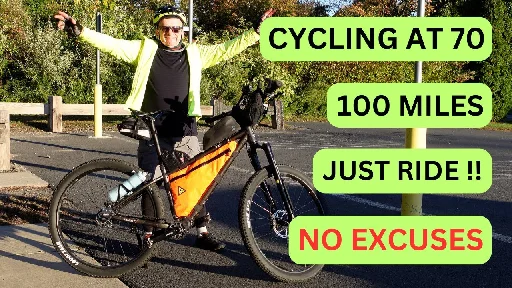
YouTube Video
Click to view this content.
- Are You a Cycling Hipster?pedalcover.co.uk Are You a Cycling Hipster? | 9 Signs to Look Out For
Whether it's exclusively drinking flat whites, wearing cycling caps or eating avocado on toast. We've narrowed down the top hipster trends of 2019.

The cycling world is awash with different kinds of people, from all walks of life, sharing one unbridled passion – riding their bikes. There are a few, however, who like to think of themselves as a cut above the rest, self-proclaimed trendsetters that love nothing more than to tell you how they were sporting a certain kind of style before it became ‘cool’.
We are, of course, talking about the cycling hipster. Here are nine signs that you may just be one of them…
You drink flat whites exclusively Coffee and cycling go hand in hand, the bean and the bike sharing close to a century of intimate history. With such a detailed history, however, comes a big debate – what type of coffee is the best? Ask a pro and they’ll tell you an espresso, maybe a cappuccino if they’re feeling cheeky. Ask one of us more leisurely riders, and we’ll probably reply with an infinite number of options, from spiced lattes to caramel frappés – whatever floats your boat really.
Ask a hipster however and they’ll only have one answer, ‘I’ll take a flat white please.’ These dainty cups of rich espresso and milky microfoam are one of the new kids on the coffee block, but that hasn’t stopped them from becoming one of the most popular choices of coffee in cycling cafés all around the country. Hipsters should be aware of this growing popularity; soon they’ll have to go and find another new and edgy coffee to obsess over. Maybe an oat milk flat white…
You wear flannel shirts while riding We’re cyclists, not pedalling lumberjacks. Riding with a flailing flannel shirt is not going to help you ride any faster, in fact, it’s going to slow you down massively. These heavy, flapping shirts basically act like parachutes when you’re on the bike, hitting you with one huge aerodynamic encumbrance.
There’s a reason the pros have been wearing tight-fitting clothing since the 1900s, let’s try to keep it that way.
You own a gravel bike Gravel bikes are one of the biggest trends in the cycling world at the moment, a craze driven largely by the US market with trendy races like the Dirty Kanza and the Filthy 50. These bikes are awesome machines, designed to glide over rough and broken roads, making them especially useful in the US where there’s a vast network of gravelled tracks and fireroads to ride on.
In the UK however, you’re going to struggle to find such ‘perfect’ stretches of gravel. Instead, what lines our roads are potholes – just as likely to induce a puncture as gravel, but far less fun to ride over. For many of us, smooth roads are an absolute luxury and something we don’t get to ride very often; no wonder we find it strange that some people would actively seek out these rough roads to ride their bikes over.
You sport a full beard and handlebar moustache Okay, we must admit, beards and moustaches are cool – they have been ever since the Vikings started rocking them a thousand years ago. What isn’t cool, however, is a beard or moustache matted with sticky energy gels and laden with crumbs; in fact, we’d go as far to say it’s downright disgusting and several pro cycling teams would agree with us.
That hasn’t stopped the hipsters though, they continue to rock up to our weekend club rides sporting full and majestic beards, clueless to the fact that in a matter of hours it’s going to be covered in a nasty concoction of sweat, drool and sticky gel. Unfortunately, even the pros at Specialized are on their side. One of their recent studies in the Win Tunnel found that beards had no adverse effect on performance, giving the green light to cycling hipsters all around the world to continue growing out their beards.
You’re too cool for brakes One of the hallmarks of a cycling hipster is the fixed geared bicycle, a bike with no brakes and just a single gear. While a cycling hipster may own a number of different bikes, their fixie will take pride of place among the fleet.
Not only are fixed gear bikes completely impractical for most kinds of riding, they’re also quite dangerous. With no brakes to help you come to a stop, your reaction time to situations happening on the road is greatly increased – bad news for both yourself and whoever else is involved. If you are going to ride a fixed gear bike, make sure you either equip it with at least one brake (on the front), or keep it solely for riding on the velodrome.
Your cycling kit is older than you Everyone likes to remember the good old days, reminiscing back to times when riders like Fausto Coppi, Eddy Merckx and Bernard Hinault were crushing and dominating races all across Europe. But that doesn’t mean we have to copy their style and wear their retro kit.
Ask anyone wearing a retro Bianchi, Molteni or La Vie Claire kit to the local club ride to name the famous rider that popularised their strip. If they answer along the lines of, ‘well, I found it in a vintage kilo sale,’ then you know they’re a cycling hipster.
You wear cycling caps, off the bike Cycling caps are fantastic little pieces of kit and do give us a chance to show off our trendy fashion tastes. But they’re not to be worn off the bike, oh no. While we will make exceptions for wearing them during café stops, or during podium celebrations, we simply cannot excuse wearing one outside of the cycling sphere.
Are you thinking of donning your retro Mapei cap to head out to the local shops? Unless you want to be brandished a cycling hipster, then don’t.
Your go-to café order is avocado on toast There are such things as popular foods, made trendy by Instagram posts and countless food-related hashtags. Right now, we’re living in the ‘Age of the Avocado’, a time when large green berries from Southern Central Mexico are dominating the menus of cycling cafés across the country.
What happened to the tasty, simple and quintessentially British delicacy of beans on toast, or the humble jacket potato? These perfect, post-ride recovery meals are slowly being phased out, much to the delight of cycling hipsters.
Your favourite ride is around Richmond Park Richmond Park is a great place to ride your bike and an ideal location for those looking for a quick escape from the hustle and bustle of central London. It is, by no means however, the best place to ride your bike.
If you start recommending the local group ride head to the park to try out the infamous Dark Hill, then they’re going to laugh you out of town. There are so many more and better places to ride your bike in the UK – just check out some of the places we’ve visited with our Great British Bike Rides series, from South Wales all the way north to the Cairngorms in Scotland.
The above is a list of ‘signs’ to help you recognise a cycling hipster, potentially even diagnose it in yourself. In truth, many of us who like to think of ourselves as traditionalists will associate with at least one of these ‘signs’, proving that you can’t really categorise such a diverse group of people. Cycling is so great because we have such a large melting pot of people – without the hipsters, it just wouldn’t be the same.
Words by Will Newton
- What Can Old Friction Shifters Teach Us? Park-Tool [Video 10:16]

YouTube Video
Click to view this content.




